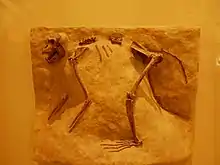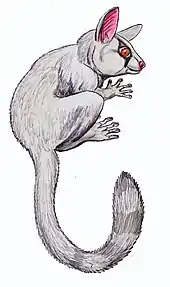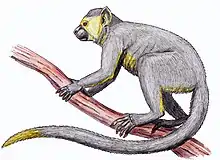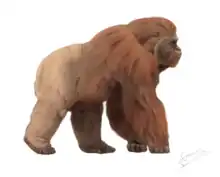| Paracolobus Temporal range: | |
|---|---|
 | |
| Paracolobus chemeroni | |
| Scientific classification | |
| Domain: | Eukaryota |
| Kingdom: | Animalia |
| Phylum: | Chordata |
| Class: | Mammalia |
| Order: | Primates |
| Suborder: | Haplorhini |
| Infraorder: | Simiiformes |
| Family: | Cercopithecidae |
| Subfamily: | Colobinae |
| Genus: | †Paracolobus R.E.F. Leakey, 1969 |
| Type species | |
| †Paracolobus chemeroni Leakey, 1969 | |
| Species | |
| |
Paracolobus is an extinct genus of primate closely related to the living colobus monkeys. It lived in eastern Africa in the Pliocene and Early Pleistocene.[1] Fossils have been found in Kenya and Ethiopia, in places such as the Omo valley.[2]
Description
Species of Paracolobus were large monkeys; P. chemeroni is estimated to have weighed between 30–50 kg (66–110 lb),[3] while P. mutiwa and the comparatively small P. enkorikae have been estimated at 39 kg (86 lb) and 9 kg (20 lb), respectively.[4] Compared to another giant monkey Cercopithecoides, Paracolobus had a longer face and deeper jaws. It had a longer cranium, broader muzzle, wider face and longer nasal bone than its closest relative, the extinct Rhinocolobus.[5] Its dentition was similar to modern colobus monkeys, indicating a largely folivorous diet.[4] Despite its large size, it was probably arboreal like its modern relatives.
References
- ↑ McKenna and Bell, 1997, p. 344
- ↑ Leakey, Meave G. (1982). "Extinct large colobines from the Plio-Pleistocene of Africa". American Journal of Physical Anthropology. 58 (2): 153–172. doi:10.1002/ajpa.1330580207.
- ↑ Brooks, Alison S. (2004). Encyclopedia of Human Evolution and Prehistory: Second Edition. Taylor & Francis. p. 188. ISBN 9781135582289.
- 1 2 Fleagle, John G. (2013). Primate Adaptation and Evolution. Elsevier Science. pp. 353–408. ISBN 9781483288505.
- ↑ Werdelin, Lars; Sanders, William Joseph (2010). Cenozoic Mammals of Africa. University of California Press. p. 405. ISBN 9780520257214.
Literature cited
- McKenna, M.C. and Bell, S.K. 1997. Classification of Mammals: Above the species level. New York: Columbia University Press, 631 pp. ISBN 0-231-11013-8



